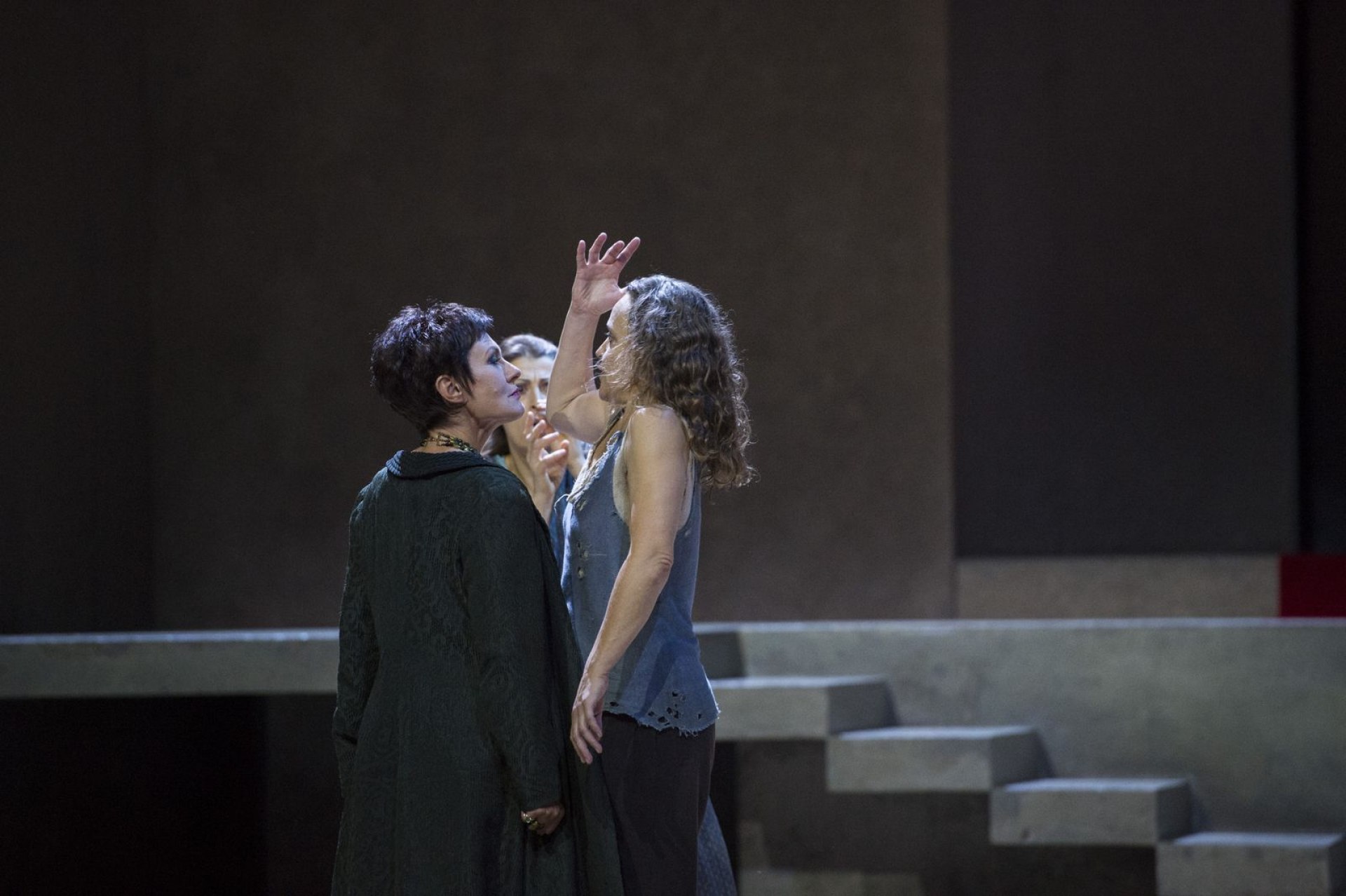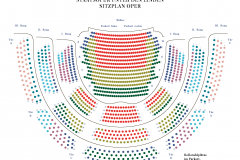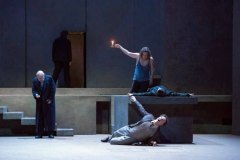Elektra
Mo | Tu | We | Th | Fr | Sa | Su |
TRAGEDY IN ONE ACT (1909)
MUSIC BY Richard Strauss
TEXT BY Hugo von Hofmannsthal
Like a call issuing from a mythical distant past, Richard Strauss’ »Elektra« summons the magic of eerie gloom and archaic brutality. An almost inevitable »tremendous increase to the very end« (Strauss) in musical tension plunges the listener deep into Electra’s world, which is shaped by grief, pain, and thirst for vengeance. Humiliated and tormented by her family, Electra, the daughter of the king of Mycenae, devotes her life to a single obsessive goal: day in and day out, she invokes the memory of her father, who was murdered treacherously by her mother Clytemnestra and Clytemnestra’s lover Aegisthus, and she waits for the return of her brother Orestes, who is supposed to avenge his father’s murder. The deed must be paid back in kind. Vacillating between hatred, hysteria, weakness, hubris, deep sadness, obsession and sarcasm, Electra has lost every connection to the people around her. She is unkempt and has rejected her femininity.
In his monumental one-act opera for dramatic voices and a giant orchestra, inspired by the powerful eloquence of his perfectly matched librettist Hugo von Hofmannsthal, the fin-de-siècle composer created a musical and psychological portrait that is extremely stirring in its expressiveness and overpowering in its tonal force. In Strauss’s own words, it brought him to the utmost limits of »psychological polyphony«
PLOT
In the courtyard of the Palace of Mycenae, the servants are wondering whether Elektra will be grieving over her father, as it is her daily mourning ritual in memory of her father. Daughter of the King Agamemnon and Clytemnestra, Elektra comes in and locks herself up in her solitude straight away. The servants all criticise and mock her, except for one, who takes her defence.
By herself, Elektra remembers how Agamemnon was assassinated upon his return from Troy, beaten up with an axe by Clytemnestra and her lover Aegistheus. Devastated by her grief, Elektra is obsessed with the revenge she intends to take together with her sister, Chrysothemis, and her brother, Orestes. The latter grew up faraway from the palace ever since he was a child and Elektra is keenly waiting for him day after day.
Chrysothemis interrupts Elektra who is caught up in her thoughts and warns her that Clytemnestra and Aegistheus have decided to lock her up in a tower. Chrysosthemis asks her sister to renounce vengeance and let life take over again. Elektra rejects the idea with disdain.
Clytemnestra arrives with her suite. She is preparing sacrifices hoping to pacify the Gods as she suffers nightmares. She wants to talk to Elektra and when her daughter’s words are more amenable than usual, she sends off her followers to stay with her. The mother asks her daughter what remedy could restore her sleep and Elektra reveals that a sacrifice may indeed free her from her nightmares. But when the Queen full of hope asks whom needs immolating, Elektra replies that it is Clytemnestra herself who needs to die. Elektra goes on to describe with frenzied elation how her mother will succumb under Orestes’ blows. Then the court is trown into a panic: two strangers have arrived and ask to be seen; a few words are whispered to the Queen, who immediately leaves without saying a single word to Elektra.
Chrysosthemis is the one who comes to bear the terrible news: Orestes had died. At first she remains deaf to what has been said, and then, loosing all hope, she concludes that only herself and her sister need to act without further delay. But Chrysosthemis refuses do commit such a deed and flees. Elektra curses her, concluding that she will need to act by herself.
One of the strangers who claims to be a friend of Orestes’ and has come to bear the news of his death has now been staying at the court for a few days. Elektra besieges him with questions. When she reveals her name, he shakes, in shock. She only recognizes him when the servants of the palace throw themselves at his feet. It is Orestes who really stands in front of her, Orestes, who tricked everybody into believing he was dead in order to sneak into the palace. Elektra is both elated and in despair; she feels boundless fondness for her brother and a fathomless sadness because of the recluse life she has chosen for herself. They are interrupted by Orestes’ tutor: the hour of vengeance has come and what Orestes has come back for now needs doing. Orestes enters the palace. Elektra listens out for the slightest noise. Clytemnestra’s scream is heard: “Hit one more time”, Elektra cries out. The Queen then draws her last gasp.
There is a moment of panic when the servants hear cries. But they flee when they are told that Aegistheus is returning from the fields. As the sun is setting, he meets with Elektra, who suddenly in a joyful mood, offers to give him light and walk him back home. Soon enough it is his turn to scream for help. He too succumbs to vengeful hands.
Chrysothemis comes out of the palace and tells her sister about their brother’s return and the double murder of Clytemnestra and Aegistheus. Elektra, hovering between ecstasy and madness, maintains that only silence and dance can celebrate their liberation. Beset by extreme frenzy, she dances until she drops: she will never be the one to have executed the act of revenge. As for Orestes, he leaves the palace, alone and in silence.
Patrice Chéreau | Vincent Huguet
Program and cast
Duration: approx. 1:45 hr – without interval
Language: In German language with German and English surtitles
Recommended age: 16 years and older
CAST
MUSICAL DIRECTOR: Simone Young
DIRECTOR: Patrice Chéreau
SET DESIGN: Richard Peduzzi
COSTUMES: Caroline de Vivaise
LIGHT: Dominique Bruguière , Gilles Bottacchi
KLYTÄMNESTRA: Evelyn Herlitzius
ELEKTRA: Iréne Theorin
CHRYSOTHEMIS: Vida Miknevičiūtė
AEGISTH: Stephan Rügamer
OREST: Lauri Vasar
DER PFLEGER DES OREST: David Wakeham
DIE VERTRAUTE, DIE AUFSEHERIN: Cheryl Studer
DIE SCHLEPPTRÄGERIN: Natalia Skrycka
EIN JUNGER DIENER: Siyabonga Maqungo
EIN ALTER DIENER: Olaf Bär
ERSTE MAGD: Bonita Hyman
ZWEITE MAGD: Natalia Skrycka
DRITTE MAGD: Anna Kissjudit
VIERTE MAGD: Clara Nadeshdin
FÜNFTE MAGD: Roberta Alexander
STAATSOPERNCHOR
STAATSKAPELLE BERLIN
State Opera Unter den Linden
Staatsoper Unter den Linden is one of Berlin's most prestigious opera houses, with a rich history and significant cultural impact.
History:
The Staatsoper Unter den Linden was originally built between 1741 and 1743, under the direction of architect Georg Wenzeslaus von Knobelsdorff. It was commissioned by Frederick II of Prussia and was initially named the Königliche Oper (Royal Opera). The opera house has undergone several renovations and reconstructions, notably after World War II damage. It reopened in 1984, following a major renovation.
Construction:
The original design was characterized by its Baroque style, featuring an elegant façade and a grand entrance. The building was reconstructed in the 1950s and 1980s, maintaining its classical exterior while modernizing the interior. The façade features a classic portico with six Corinthian columns and a prominent central pediment.
Interior:
The interior is known for its opulent and classical design. The auditorium is renowned for its acoustics and grandeur, with luxurious velvet seats and elaborate decorations. The stage and seating areas have been updated to meet modern performance standards while preserving historical aesthetics.
Concerts and Performances:
The Staatsoper Unter den Linden hosts a variety of performances, including operas, orchestral concerts, and ballet. It is home to the Staatskapelle Berlin, one of Germany's leading orchestras. The opera house is celebrated for its high-quality productions and its role in Berlin’s vibrant cultural scene.
JOURNEY
The Staatsoper Unter den Linden has completely barrier-free access due to its excellent public transport connections.
ADDRESS: Unter den Linden 7; 10117 Berlin
SUBURBAN RAILWAY
S+U Friedrichstraße (S1, S2, S5, S7, S25, S75)
SUBWAY
Hausvogteiplatz (U2)
Museumsinsel (U5)
Stadtmitte (U2, U6)
Unter den Linden (U5, U6)
BUS
Staatsoper (100, 245, 300)
Unter den Linden/Friedrichstraße (100, 147, 245, 300, N6)
PARKING
Q-PARK parking garage Unter den Linden/Staatsoper
Bebelplatz, 10117 Berlin
There are five electric charging stations in the parking garage. Further information can be found here.
The underground car park on Bebelplatz offers disabled parking spaces and direct access to the opera house. On entering the car park between 5.30pm and 11.30pm, the maximum parking fee is €7. To use this tariff, enter your parking ticket in one of the pay machines and the message »Theatertarif« will appear on the display. Please note that it is not possible to use the tariff if you enter the car park before 5.30pm. so it will not be shown on the display. TIP: If you pay the theatre tariff at the pay machine before the event, you can avoid unnecessary waiting after the show.

 EN
EN DE
DE IT
IT FR
FR ES
ES RU
RU JP
JP RO
RO
 Seating plan
Seating plan 

